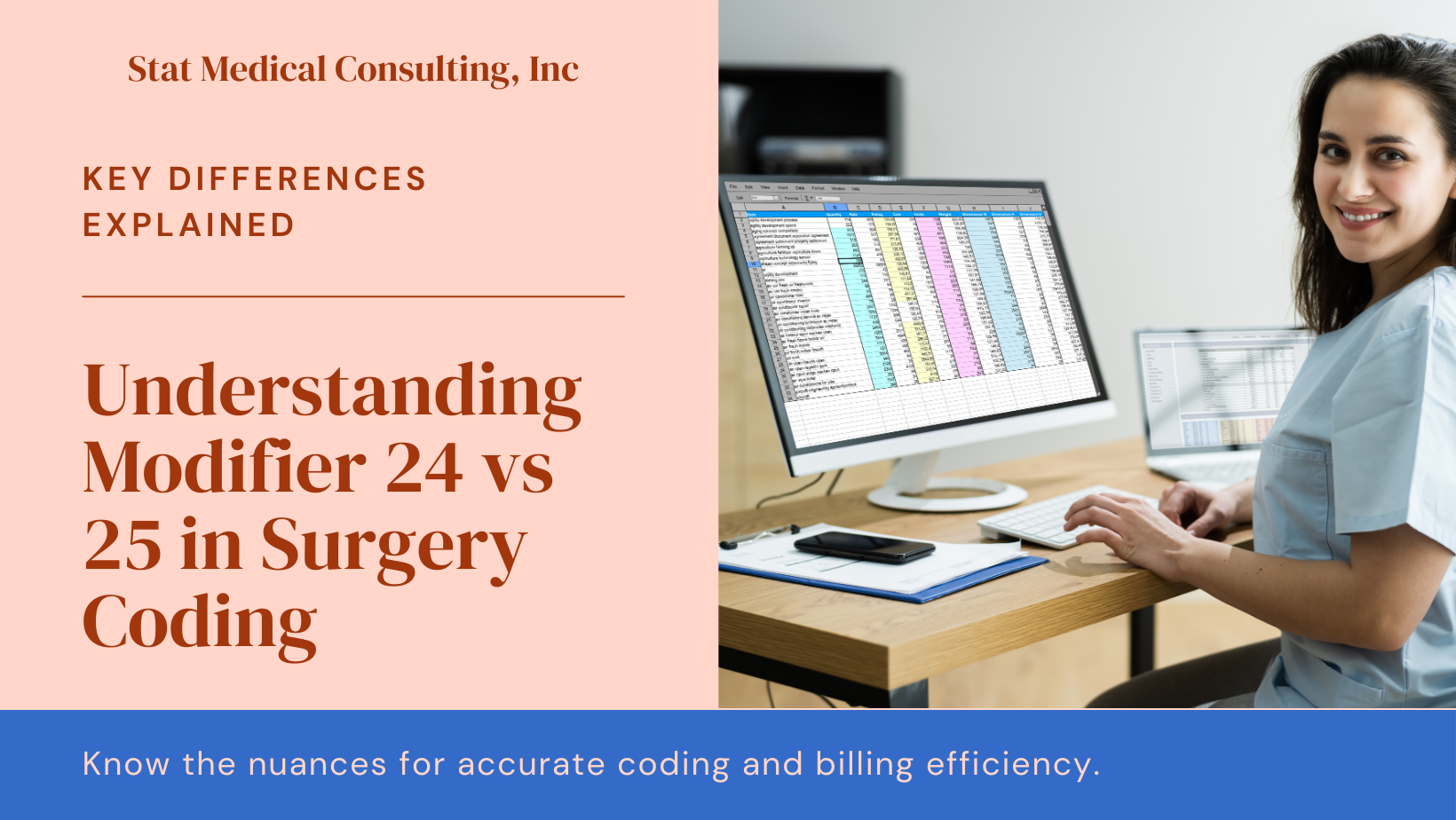Correct Use of Modifiers 24 and 25
MODIFIER 24 VS 25

One of the most frequent mistakes arises from submitting invalid modifier combinations. Besides accurately coding the treatment, medical claims must also include codes for additional services performed. Common error involves using modifier 24 and 25 incorrectly.
Where Modifier 24 is Applicable?
Modifier 24 is applied to evaluation and management services provided during a postoperative care , but unrelated to the surgery itself.
Where Modifier 25 Comes in Handy?
On the other hand, modifier 25 indicates that evaluation and management services are distinct services rendered by the same healthcare professional on the same day.
A crucial aspect of correctly using modifiers 24 and 25 is understanding the global period for procedures, which can be zero, 10, or 90 days post-procedure and might include additional preoperative days.
Understand the Correct Use of Modifier 24
- Modifier 24 For some specialists, the use modifier 24 is frequently used when providing co-management services.
- This modifier is defined as an “unrelated evaluation and management service by the same physician during the postoperative period.” Essentially, if a patient has undergone surgery and subsequently requires an evaluation for a condition that is entirely separate from the surgery, the evaluation and management (E/M) service would be reported with modifier 24.
- Ophthalmologists commonly use modifier 24 in situations where the patient develops an eye condition in the non-operated eye and therefore the eye problem in the operated eye that is unrelated to the surgery.
- This modifier is exclusively applied to E/M services.
- It is essential to include thorough documentation that clearly explains why the visit during the postoperative period is unrelated to the surgery.
Proper Application of Modifier 24
One clinical example:
- A 4-year-old patient, who had an intermediate layered closure performed on a 2.5-cm laceration on the right anterior wrist five days ago (CPT code 12031), returns to the physician’s office. Today, the patient is experiencing bilateral ear pain, and his mother reports that he was crying throughout the night.
- The physician conducts an expanded problem-focused history and examination, diagnosing the patient with bilateral otitis media. The doctor prescribes amoxicillin and advises the mother to return in seven days for a follow-up on the child's ears.
- In this case, the coder correctly assigns the CPT code 99213-24 for the office outpatient visit of an established patient, including an expanded problem-focused history, an expanded problem-focused physical exam, and medical decision-making of low complexity.
Understand the Correct Use of Modifier 25
Modifier 25 is used to denote “a significant evaluation and management (E/M) service by the same physician on the same day as a procedure.” This modifier applies when the E/M services go beyond the typical preparation and follow-up care associated with a procedure. Therefore, if additional E/M services are necessary on the day of the procedure, they should be reported with modifier 25.
For instance, in the case of removing a foreign body or closing a punctum with a punctal plug, reporting modifier 25 may be required. While many E/M services are standard parts of surgical procedures—such as obtaining a patient's ocular and general medical history, performing an external exam, evaluating distance vision, and conducting a slit lamp examination—additional E/M services might still be necessary.
Take, for example, a scenario where a patient presents for glaucoma treatment, and during the evaluation, a foreign body is identified. In this situation, the evaluation for glaucoma and the foreign body removal would both be reported, with the E/M service documented using modifier 25.
It’s important to remember that modifier 25 should only be used when reporting E/M services. The documentation must clearly indicate the necessity of the E/M service to ensure reimbursement, particularly when the E/M service occurs on the same day as a procedure. This indicates that the E/M service is significant and separately identifiable, beyond the usual pre-and postoperative work of the procedure.
All doctors should keep in mind the importance of accurate and thorough documentation to justify the use of modifier 25.
Proper Application of Modifier 25
Modifier 25 is applied to report separately identifiable E&M services performed on the same day as another procedure, which includes surgical procedures, labs, X-rays, and supply codes documented by the physician. This modifier is used when the E&M service is prompted by the symptom or condition that necessitated the procedure and/or service. In instances where a procedure was not anticipated during the patient's visit, the E&M service can be reported with modifier 25.
For example, a patient arrives at the emergency department complaining of lower back pain with sharp pains radiating down both legs. After evaluation, the patient receives an intramuscular (IM) injection of Toradol for pain relief. The visit is assigned a level 3 facility E&M level and coded as 96372 for the IM injection. No modifier 25 is appended to the E&M level because the status indicator is N (packaged service). Modifier 25 would be assigned only if the status indicator were S, T, or Q1–Q3.
Understanding when to use modifiers 24 and 25 in E&M coding can be challenging, but the guidelines above can clarify their application. Recognizing the global period for procedures is crucial, as it simplifies determining when to assign modifier 24 or 25.
Conclusion
In conclusion, correctly applying modifiers 24 and 25 is essential for ensuring accurate medical billing and avoiding claim denials. Many errors in modifier usage can be prevented with properly trained medical coding personnel. Partnering with experts, like those at Stat Medical Consulting, can make a significant difference. Stat Medical Consulting, with 30 years of experience, knows medical coding inside and out and offers free billing analysis to pinpoint issues leading to claim rejections. If you want to enhance your billing accuracy and optimize reimbursements, consider connecting with professionals who specialize in medical coding. Contact us at (818) 907-7828 or
online to learn more about our services and how we can help you achieve your revenue goals.










